CPC Definition - Subclass G03G
This place covers:
Materials, methods and machines for forming permanent, directly-visible pictures in conformity with an original picture or document by using intermediate, i.e. latent, imagewise patterns.
Examples of latent, imagewise patterns are:
- charge patterns (electrophotographic copying)
- electric conductivity patterns (radiation field photography, photoelectrophoresis, electrophoto-adhesive processes)
- magnetic patterns (magnetography, thermomagnetic recording)
If the invention is directed to electrophotographic copying /printing, which is mostly identified by features related to:
- the charging and decharging of a photosensitive medium;
- the formation of (charge) patterns representing the original document as latent (charge) image;
- exposing and illumination means for a photosensitive medium;
- the use of black, coloured or transparent developer material (toner) for developing, transferring and fixing;
then such document should be classified in this subclass.
In this subclass there two different main classification sections, namely the chemical or materials part and the method and apparatus part.
Classification of materials for use in:
- image-recording members, photosensitive materials: G03G 5/00
- image forming apparatus, e.g. developers, fixing agents: G03G 9/00, G03G 11/00
Classification of processes and machines for image forming images:
Arrangements for selective printing mechanisms, inkjet printer, handling of sheets and webs for printing: B41J
Arrangements for scanning and reproduction of documents, in combination e.g. laser printer and electrographic copying machines, image data conversion: H04N.
Arrangements for digital outputting image data to printing units, image data conversion: G06F
Arrangements for producing a permanent visual representation of output data, laser beam printer, image data processing: G06K.
This place does not cover:
Selective printing mechanisms, production of prints by transferring ink from a printing form to a printing surface without physical contact and using the force of an electrostatic field, e.g. ink jet printers | |
Duplicating or marking methods not using an electrostatic or magnetic patterns, e.g. by heat patterns | |
Digital stores using thermoplastic elements | |
Transmission of image information from the original to a reproduction apparatus using electric signals |
Attention is drawn to the following places, which may be of interest for search:
Inkjet printers | |
Handling of sheets and webs in printing apparatus | |
Handling of thin materials, webs | |
Laser printers | |
Scanning, transmission or reproduction of documents |
If a document describes non-invention information directed to process means for charging, exposing, developing transferring or cleaning an Indexing Code under an appropriate subgroup of G03G 2215/00 or G03G 2221/00 should be given.
In patent documents, the following words/expressions are often used as synonyms:
- "electrographic", "electrostatographic", "electrophotographic","photoconductive" and "xerographic"
- "toner" and "developer"
- "cartridge" and "container"
In patent documents, the following words/expressions are often used with the meaning indicated:
"process cartridge or unit", "image forming cartridge or unit" and "developing cartridge or unit" | of a unit comprising both the photosensitive, latent image recording member and the toner developing means, although they quite often describe those units of an image forming apparatus only comprising toner developing means. |
This place covers:
Compounds for treating recording members, such as cleaning, reactivating, polishing or heating (G03G 5/005).
Recording layers in a recording member such as charge receiving layers, photoelectret layers and photoconductive layers (G03G 5/02-G03G 5/05).
Other layers in a recording member such as bases (supports), intermediate layers and cover (protective) layers (G03G 5/10-G03G 5/14).
Coating methods of the different layers (G03G 5/0525).
Selection of specific materials in said layers such as macromolecular bonding materials (G03G 5/0528), photoconductive material (G03G 5/06- G03G 5/08) and sensitizer or activators (G03G 5/09).
Charge-receiving layers combined with additional photo-or thermo-sensitive layers (G03G 5/153).
Layers for recording by changing magnetic properties (G03G 5/16).
Documents essentially dealing with the mechanical aspects of the recording member are classified in G03G 15/00 and G03G 21/00.
This place covers:
Materials, fluid or solid compounds used from treating the recording members: for cleaning, reactivating or polishing.
This place does not cover:
Protective layers on top of the recording layer | |
Coatings on the final image receiving member after printing process | |
Fusing agents used in toner particles during the fixing process on image receiving members |
This place covers:
Recording layers others than photoconductive layers such as dielectric layers or photoelectret layers. This sub group is further subdivided according to the different resins in the charge-receiving layers and other components.
Further details of subgroups
G03G 5/0202 covers recording layer being a dielectric layer:
of insulating material which is generally on a conductive backing so that when charged as with a corona discharge electrode, an electrostatic charge pattern is retained only on the patterned insulating sections of the dielectric layer
G03G 5/0205 covers said charge-receiving layer comprises polymeric components.
G03G 5/0208 said polymeric components are obtained by reactions only involving carbon-to-carbon unsaturated bonds.
G03G 5/0211 said polymeric components are obtained otherwise than by reactions only involving carbon-to-carbon unsaturated bonds.
G03G 5/0214 charge-receiving layer containing organic non-macromolecular components, such as wax, fatty acids, pigments.
G03G 5/0217 charge-receiving layer contains inorganic components, such as inorganic filler, silica.
G03G 5/022 covers a recording layer which is a layer for surface-deformation, e.g. frost imaging: comprising the method steps: - (a) uniformly charging the layer to below the threshold which produces frosting when heated without exposure to light; (b) image wise exposing the layer after completing the charging; (c) heating the layer using a flat, radiant heater, the heating being carried out towards the end of but within the image wise exposure period, which causes positive to positive imaging. The low charging voltage reduces damage to the recording layer during repeated imaging cycles.
G03G 5/024 covers a recording layer which is a photoelectret layer: comprising magnetic components with phase transition or functions as a photoelectret. The particles are able to line up in filaments with their dipole moment oriented along the lines of magnetic force at right angles to the surface of the carrier. The softening temperature of the binder is lower than the temperature of recording.
G03G 5/026 covers a recording layers in which during the irradiation a chemical reaction occurs, whereby electrically conductive patterns are formed in the layers, e.g. chemixerography.
G03G 5/028 recording layers in which after being exposed to heat patterns electrically conductive patterns are formed in the layers, e.g. thermo xerography.
This place does not cover:
Photoconductive layers | |
Charge-receiving layers combined with additional photo or thermo-sensitive - not photoconductive - layers |
In the absence of an indication to the contrary, classification is made in the last appropriate place.
Example:
Polyester binder resins: G03G5/02B4C.
Documents dealing with binder resins and additional non polymeric compounds should be classified in both corresponding subgroups.
This place covers:
Image-recording layers that contain photosensitive components; the particular types of photoconductive recording layers, i.e. dual layers including separate charge-generating layers and charge-transporting layers; single photoconductive layers and additives and binders used in such photoconductive layers. This sub groups is further subdivided according to the structure of the layers and the chemical composition.
Further details of subgroups
G03G 5/043 photoconductive layers characterised by having two or more layers or characterised by their composite.
This subgroup should only contain documents characterised by the structure of the layers. Structure in general would also cover single layer or multilayers. The last place rule applies.
G03G 5/0433 all photoconductive layers being inorganic, i.e. the photoconductive agent (and if present) the bonding material being inorganic, the bases for the photoconductive layers however may be of any material.
G03G 5/0436 the photoconductive layers combining organic and inorganic layers
G03G 5/047 characterised by the charge-generation layer or the charge transport layer, e.g. a particular selection of charge generation material (e.g. phthalocyanine pigment) and charge transport material (e.g. triphenylamine). G03G 5/0433 and G03G 5/0436 take precedence.
This place covers:
Organic (polymeric) bonding material employed in an electrophotographic photoconductive layer, in particular in a charge transporting layer and charge generating layer or in a single photosensitive layer and the method for coating a substrate with a photoconductive layer. It also includes inert supplements, e.g. an inhibitor or filler; which do not function as an active component in the photoconductive layer.
Further details of subgroups
G03G 5/0503 inert supplements not functioning as photoconductive material, resins or colorants in the photoconductive layer (not further specified): might function as inhibitor or filler in the photoconductive layer.
G03G 5/0507 inorganic compounds.
G03G 5/051 organic non-macromolecular compounds.
G03G 5/0514 not comprising cyclic groups.
G03G 5/0517 comprising one or more carbocyclic groups consisting of carbon-to carbon atoms only.
G03G 5/0521 comprising one or more heterocyclic groups.
G03G 5/0525 coating methods of a photoconductive layer; coating methods such as dip coating, conventional thermal coating, spraying.
G03G 5/0528 macromolecular bonding materials; the binder resins in a recording layer are subdivided according to addition polymerisation and condensation polymerisation: G03G 5/0532 and G03G 5/0557. These groups are further subdivided according to their chemical composition. In the absence of an indication to the contrary, a polymer is classified in the last appropriate place, for example:
Polyester binder resin employed in a recording layer: G03G 5/056
G03G 5/0589 - G03G 5/0596: polymers in the recording layer characterized by the chemical or physical properties.
Polymers characterised by the composition and physical or chemical properties should always be classified in both: the composition groups G03G 5/0532 - G03G 5/0589 and as well in the parameter-groups G03G 5/0592 and G03G 5/0596.
Polymers with photoconductive side chains or end (terminal) groups should only be classified in G03G 5/07.
Documents in which the recording member in general is characterised by chemical or physical properties caused by the binder resin should also be classified in G03G 5/0589 - G03G 5/0596.
This place does not cover:
Macromolecular photoconductive materials in the recording layer | |
Electroconductive macromolecular material employed in the base | |
Organic (polymeric) bonding material employed in the intermediate layer | |
Organic (polymeric) bonding material employed in the cover layer |
This place covers:
Organic and organo-metallic non-polymeric photoconductive compounds in a photosensitive layer (double layered photosensitive layer comprising charge transporting layer or charge generating layer or single-layered photosensitive layer including charge generation material and charge transporting material).
Further details of subgroups
G03G 5/0601 Acyclic or carbocyclic compounds: any (substituted) non-hetero cyclic compound such as aromatic rings, aliphatic rings.
G03G 5/0605 carbocyclic compounds with halogen groups substituted to ring.
G03G 5/0609 any carbocyclic with an oxygen-containing functional group, such as keto- ketal- carboxylic acids, aldehydes, alcohols, anhydrides.
G03G 5/0611 Squaric acid: also called as quadratic acid, because its four carbon atoms approximately form a square, C4H2O4.
G03G 5/0614 containing any non-heterocyclic compound substituted with prim., sec. or tert. amino; e.g. triethanolamine. Heterocyclic amines classify in G03G 5/0622 – G03G 5/0661 as appropriate.
G03G 5/06142 containing a compound having an arylamine group, i.e., compounds of the formula R2NR" wherein: R" is an aryl group, and R is hydrogen, or a carbon containing group.
G03G 5/06144 containing an arylamine compound having two amino nitrogens, e.g., of the formula R2N-R"-NR2 wherein: R" is an aromatic group and R is hydrogen, or a carbon containing group.
G03G 5/061443 containing the diamine R2N-Ph-Ph-NR2, wherein: Ph-Ph is biphenylene and R is hydrogen or a carbon containing group.
G03G 5/061446 containing the diamine R2N-Ph-Ph-Ph-NR2, wherein: Ph-Ph-Ph is terphenylene and R is hydrogen or a carbon containing group.
G03G 5/06145 containing an arylamine compound having three amino nitrogens or greater connected to an aryl group.
G03G 5/06147 containing an arylamine compound having an alkenyl group bonded, directly or indirectly, to amino nitrogen (e.g., compounds having the formula R2N-R"-CR=CR2, wherein: R" is an arylene group and R is hydrogen or a carbon containing group).
G03G 5/061473 containing an arylamine compound having two or more alkenyl group bonded, directly or indirectly, to amino nitrogen (e.g., compounds having the formula R2N-R"-CR=CR-CR=CR2, wherein: R" is an arylene group and R is hydrogen or a carbon containing group).
G03G 5/06149 containing an amine compound having an alkenyl group bonded, directly or indirectly, to amino nitrogen (e.g., compounds having the formula R2N-R"-CR=CR2, wherein: R" is an alkylene group and R is hydrogen or an aliphatic carbon containing group).
G03G 5/0618 any non-hetero cyclic compound substituted with oxygen and nitrogen; e.g. (di-)cyano-, urea, nitro-, amido-substitution.
G03G 5/062 any non-hetero-cyclic compound substituted with non-metallic elements, such as Si (other than H, Hal, O or N).
G03G 5/0622 any aromatic ring not covered by G03G 5/0624.
G03G 5/0624 containing one single hetero ring in the compound.
G03G 5/0644 containing two or more hetero rings in the same compound.
G03G 5/0646 containing two or more hetero rings in the compound in the same ring system including all cyclic rings - also the carbocyclic elements and the heterocyclic elements of the ring system, e.g. quinacridone. Ring system of at least two hetero-rings, further divided by the number of all rings, including also the non-heterocyclic rings. For example, perylene.
G03G 5/0661 containing two or more hetero rings in the compound in different ring systems each system contains at least one hetero ring, e.g. oligomers of quinacridones.
G03G 5/0662 any organ metallic non-macromolecular compound that contains metal elements [N. note alcoholates, phenates or organic acid salts of alkali or alkaline earth metals are classified as parent compounds, e.g. organometallic dyes should be classified in G03G 5/0664]: e.g. zirconocene.
G03G 5/0664 Dyes, should be regarded in a more general meaning, i.e. a compound in a photoconductive layer that function as a photosensitive material, not only restricted to colouring agents.
G03G 5/0666 dyes containing a methine or polymethine group in the compound; in case the polymethine is located between two or three azo groups classification is made in the last appropriate place, document should only be classified in G03G 5/0683 or G03G 5/069.
G03G 5/0668 dyes containing only one methine or polymethine group.
G03G 5/067 dyes containing only one methine or polymethine group and one or more hetero ring(s).
G03G 5/0672 dyes containing two or more methine or polymethine group.
G03G 5/0674 dyes containing two or more methine or polymethine group and one or more hetero ring(s).
G03G 5/0675 azo dyes.
G03G 5/0677 monoazo dyes.
G03G 5/0679 disazo dyes.
G03G 5/0681 diazo dyes containing hetero rings between the azo groups.
G03G 5/0683 diazo dyes containing polymethine or anthraquinone groups between the azo groups.
G03G 5/0685 diazo dyes containing hetero rings between the between the azo groups.
G03G 5/0687 trisazo dyes.
G03G 5/0688 trisazo dyes containing hetero rings between the azo groups.
G03G 5/069 trisazo dyes containing polymethine or anthraquinone groups between the azo groups.
G03G 5/0694 azo dyes containing more than 3 azo groups in the compound.
G03G 5/0696 phthalocyanine dyes: documents dealing with other dyes which are structurally very similar to phthalocyanine dyes such as naphthocyanines or phorphorines or the like should also be classified in this group.
G03G 5/0698 any photosensitive agent in a recording layer of unspecified structure characterised by a substituent, such as a charge carrying agent.
This place covers:
Any type of macromolecular photoconductive compounds. The polymeric photoconductive compounds are further subdivided according to the method of polymerisation and by the photoconductive group, which can be part of the macromolecular compound's backbone or pendant from the backbone.
Further details of subgroups
G03G 5/071 containing macromolecular photoconductive compounds obtained by polymerisation of compounds having carbon-to-carbon unsaturated bonds (e.g., acrylate, styrene, etc.) and having a photoconductive group.
G03G 5/072 containing a macromolecular photoconductive compounds obtained by polymerization of compounds having carbon-to-carbon unsaturated bonds and having a single amine as a pendant group. The amine group can be part of a repeating unit of the macromolecular compound.
G03G 5/073 containing a macromolecular photoconductive compounds obtained by polymerization of compounds having carbon-to-carbon unsaturated bonds and having a carbazole group as a pendant group. The carbazole group can be part of a repeating unit of the macromolecular compound.
G03G 5/0732 containing a macromolecular photoconductive compounds obtained by polymerization of compounds having carbon-to-carbon unsaturated bonds and having an alkenylarylamine group as a pendant group, where the alkenylarylamine is an amine compound having an alkenyl group bonded, directly or indirectly, to amino nitrogen (e.g., compounds having the formula R2N-R"-CR=CR2, wherein: R" is an arylene group and R is hydrogen or an aliphatic carbon-containing group and at least one is a carbon containing radical that links directly or indirectly to the backbone of the macromolecular compound). The alkenylarylamine group can be part of a repeating unit of the macromolecular compound.
G03G 5/074 containing a macromolecular photoconductive compounds obtained by polymerization of compounds having carbon-to-carbon unsaturated bonds and having a diamine group as a pendant group. The diamine group can be part of a repeating unit of the macromolecular compound.
G03G 5/0745 containing a macromolecular photoconductive compounds obtained by polymerization of compounds having carbon-to-carbon unsaturated bonds and having a hydrazone group as a pendant group. The hydrazone group can be part of a repeating unit of the macromolecular compound.
G03G 5/075 containing macromolecular photoconductive compounds formed from other than polymerization of compounds having carbon-to-carbon unsaturated bonds (e.g. a condensation reaction to form a polyester).
G03G 5/076 containing a macromolecular compound formed from other than polymerization of compounds having carbon-to-carbon unsaturated bonds and having a photoconductive moiety as part of the polymer backbone.
G03G 5/0763 containing a macromolecular compound formed from other than polymerization of compounds having carbon-to-carbon unsaturated bonds and having an arylamine group as part of the polymer backbone.
G03G 5/0764 containing a macromolecular compound formed from other than polymerization of compounds having carbon-to-carbon unsaturated bonds and having a triarylamine group as part of the polymer backbone.
G03G 5/0765 containing a macromolecular compound formed from other than polymerization of compounds having carbon-to-carbon unsaturated bonds and having an alkenylarylamine group as part of the polymer backbone.
G03G 5/0766 containing a macromolecular compound formed from other than polymerization of compounds having carbon-to-carbon unsaturated bonds and having a benzidine group as part of the polymer backbone.
G03G 5/0767 containing a macromolecular compound formed from other than polymerization of compounds having carbon-to-carbon unsaturated bonds and having a hydrazone group as part of the polymer backbone.
G03G 5/078 polysilicone photoconductive resin; any type of silicon-containing polymer.
Documents containing a photoconductive resin in an additional surface layer or intermediate layer should also be classified in G03G 5/07.
This place covers:
Any type of inorganic photoconductive compounds in the recording layer of the photo drum.
Last place rule applies.
Classification in the inorganic head group G03G 5/08 and in organic head group G03G 5/06 if a document relating to inorganic and organic photoconductive materials cannot be classified in the inorganic photoconductive subgroups G03G 5/082 - G03G5/082E (only inorganic photoconductive material) or in G05G5/085 (inorganic photoconductive material and inorganic bonding material) and in any of the appropriate organic photoconductive groups G05G5/06B - G03G5/06K. e.g Selenium particles in a polycarbonate are classified in G03G 5/087 (inorganic material being incorporated in an organic bonding material)
Further details of subgroups
G03G 5/082 inorganic photoconductive agents which are not incorporated in a matrix of polymeric resin. The complete photoconductive layer is obtained by vacuum deposition, no binder resin is present.
G03G 5/08207 selenium based photoconductive agent.
G03G 5/08214 silicon based photoconductive agent. This group is subdivided according to the numbers of active inorganic photosensitive layers and again according a uniform distribution or a non-uniform distribution of inorganic material in the recording layer: G03G 5/08221, G03G 5/08228, G03G 5/08235, G03G 5/08242, G03G 5/0825, G03G 5/08257, G03G 5/08264, G03G 5/08271
G03G 5/08278 preparation process of said inorganic photosensitive layers: depositing methods. Deposition method defines silicon-based photoconductive layer.
G03G 5/08285 carbon-based photoconductive agent; in case C is mixed with Si in the photosensitive layer, document should be classified in G03G 5/08214.
G03G 5/08292 germanium-based photoconductive agent; in case Ge is mixed with Si in the photosensitive layer, document should be classified in G03G 5/08214
G03G 5/085 the photosensitive layer contains inorganic photoconductive agents in an inorganic matrix, such as glass-like layers, ceramic layers or the like.
G03G 5/087 the photosensitive layer contains inorganic photoconductive agents in polymeric binder matrix.
This place covers:
Any compound which activates or sensitizes the photoconductive material in the photosensitive layer.
Said compounds which activate or sensitize the photoconductive material in the photosensitive layer: dyes which are sensitising agents for different light bands such as a pigment sensitizing dopant having an electron acceptor molecule or near infrared absorbing materials.
This place does not cover:
Recording members for multicolour processes |
This place covers:
Substrates for image recording members.
The classifier should not only classify any substrate of an image recording member but also strippable back sheets, (curling) back layers adjacent to the substrate. G03G 5/10 is further subdivided according to the chemical composition of the substrate:
G03G 5/101 covers paper; G03G 5/102 covers metal substrates such as gold or aluminium; G03G 5/104 covers substrates comprising inorganic compounds such as carbon nanotubes, salts, metal oxides or carbon black; G03G 5/105 any electrically-conductive macromolecular compound, such as ionic cellulose derivatives (last place rule applies); G03G 5/107 cationic electroconductive polymers, such as quaternary ammonium polymers; G03G 5/108 anionic electroconductive polymers, such as those containing carboxylic acid.
This place covers:
Image recording members used in electrophotographic multi-colour processes using two or more colours (developing agents).
Electrophotographic imaging members with photoconductive layers sensitive to red, green and blue light, accomplished with several different photoconductive layers or with a single panchromatic photoconductive layer using a green-, blue-, red- and white-filter.
Attention is drawn to the following places, which may be of interest for search:
Apparatus for producing multicoloured copies |
This group is not used for classification.
This place covers:
Intermediate layer, subbing layer, undercoat layer or inner layer - located between the substrate and the photosensitive layer and cover layer, top layer or protective layer - coated on top of the charge-receiving layers.
This place does not cover:
Photoconductive layers; Charge-generation layers or charge-transporting layers; |
This place covers:
Intermediate layers that are not photoconductive layer or back layer or subbing layer.
This place covers:
Intermediate layers comprising inorganic compounds or organo-metallic compounds.
This place covers:
Layers on top of the photoconductive layer(s): protecting layer, top layer, coating layer.
The polymers in the cover layers are further subdivided according to addition polymerisation and condensation polymerisation material-groups G03G5/147B - G03G5/147D2D16 and according to the properties in the parameter-groups G03G5/147D2H and G03G5/147D2K. Documents dealing with specific polymers not only defined by composition but also by the properties should be classified in both groups: composition group and parameter group. Protective layers which does not only function as a protective layer but also as a photoconductive layer should be classified in G03G 5/05, G03G 5/07.
This place covers:
Charge receiving layers which are combined with other photosensitive or thermo-sensitive layers; providing localised heating to a medium comprising a thermally-activatable component of an imaging forming system or to a photoconductive layer system a light-sensitive layer is added.
This place covers:
Magnetic recording layers in an imaging element composed of magnetic particles which changes the magnetic properties during recording process.
This place covers:
Image-receiving members in electrophotographic imaging in processes and the manufacturing thereof. This subclass is further subdivided according to the different types of layers: cover layers, intermediate layers, back layers and substrates and their chemical composition.
Further details of subgroups
Cover layers for image-receiving members, strippable cover sheets;
inorganic components are classified in G03G 7/0006
Inorganic components: G03G 7/0013
Organic components: G03G 7/002
Macromolecular components: G03G 7/0026
Macromolecular components being natural or derivates thereof: G03G 7/0033
Macromolecular components being obtained by reactions only involving carbon-to-carbon unsaturated bonds: G03G 7/004
Macromolecular components being obtained by reactions obtained otherwise than only involving carbon-to-carbon unsaturated bonds G03G 7/0046
G03G 7/0053 Intermediate layers for image-receiving members.
Substrates for image-receiving members; image-receiving members comprising only one layer is classified in G03G 7/006
Inorganic components: G03G 7/0066
Organic components: G03G 7/002
Macromolecular components: G03G 7/0026
G03G 7/0086 Back layers for image-receiving members, strippable back sheets
G03G 7/0093 Image-receiving members based on materials other than paper or plastic sheets, e.g. textiles, metals, ceramics, CD or DVDs.
This place does not cover:
Intermediate transfer members in an image forming apparatus | |
Photosensitive materials for photographic purposes | |
Photosensitive material for optical recording purposes |
Attention is drawn to the following places, which may be of interest for search:
Means for transferring a pattern to a second (permanent) base | |
Image receiving members in inkjet processes | |
Specific properties in the paper substrates of the image receiving members |
This place covers:
Top layers covering the final printed image receiving member, e.g. for protecting, for writing thereon.
Method of generating simulated photographic-quality images by providing a protective layer on the printed image are classified in G03G 15/00.
This place covers:
All types of developers comprising all types of toner particles and all types of carriers, including dry and liquid developers.
This includes:
- toner particles and carrier particles of dry two-component developing agents
- magnetic toner particles
- toner particles and liquid carrier of liquid developers
The toner particles are further sub-grouped by their components such as binders, colorants or dyes, plasticisers, charge control agents and compositions.
The carrier particles are further sub-divided by magnetic and non-magnetic particles and binders.
This place further includes the properties and manufacture for the toner particles.
This group also includes the properties of the carrier particles and the manufacture of the coating of the carrier particles
In the subgroups of G03G 9/0802 - G03G 9/1355, the last place priority rule is applied, i.e. at each hierarchical level, in the absence of an indication to the contrary, classification is made in the last appropriate place.
However, in the subgroups of G03G 9/0835 - G03G 9/0839, G03G 9/08786 - G03G 9/08797, G03G 9/0926 - G03G 9/0928 and G03G 9/10 - G03G 9/10884 the common rule is applied.
Further details of subgroups
Electrolytic developers are classified in subgroup G03G 9/06.
Liquid developers should be classified in G03G 9/12.
Toner particles are classified in subgroup G03G 9/08 and further subdivided according to their preparation method for producing, their chemical composition and their properties and components.
G03G 9/0802 covers preparation method for producing the toner particles.
G03G 9/0806 covers chemical synthesis of at least one toner component (e.g. polymeric binder) takes place during the toner preparation process, in situ.
G03G 9/0808 covers dry mixing of toner components in solid/softened state.
G03G 9/081 covers reactive mixing of the toner components in a liquefied state, melt kneading, and reactive mixing with a co-extruder.
G03G 9/0819 covers the characteristics of the toner particles, such as particle size and particle size distribution.
G03G 9/0821 covers the physical characteristics and chemical parameters of the toner particles, in case the toner parameters are caused by the toner binder resins the document should be classified in both G03G 9/08795 and G03G 9/08797.
Magnetic toner particles and their parameters should be classified in G03G 9/083.
G03G 9/0825 covers the structure of the toner.
G03G 9/0827 covers the shape of the toner such as degree of sphericity, shape factor SF1, SF2, roundness, needle-like shape, potato-like shape, and lamellar shape.
Physical properties of the magnetic components in the magnetic toner should only be classified in G03G 9/0835 - G03G 9/0839.
Physical or chemical properties of the nonmagnetic components in the magnetic toner are classified in G03G 9/0821 - G03G 9/0827.
In G03G 9/0836, examples of other physical properties of the magnetic toner covered in this group include electrical properties, true density, and apparent density. Specific properties of the magnetic toners, relating to the shape are covered in G03G 9/0837 and to the particle size in G03G 9/0838. These shape-properties and particle size properties are consequently excluded from G03G 9/0836. Documents relating to a process for manufacturing of a magnetic toner exhibiting the said qualities should be classified in the corresponding method classes (i.e. G03G 9/0802 - G03G 9/0817, which consist of toners in general: magnetic and nonmagnetic toners) as well as in the properties groups of magnetic toners.
Moreover, the binder resin, the colorant, the plasticisers and charge control agents of a magnetic toner should be classified in G03G 9/087, G03G 9/09, and G03G 9/097, respectively.
G03G 9/087 covers the binders for the toner particles.
This group is further subdivided according to the chemical composition of the toner binder resin, such as macromolecular compounds obtained by reactions only involving carbon-to-carbon unsaturated bonds (e.g. polyaddition) covered by G03G 9/08702 - G03G 9/0874, macromolecular compounds obtained otherwise than by reactions only involving carbon-to-carbon unsaturated bonds (e.g. polycondensation) covered by G03G 9/08742 - G03G 9/08773 and natural macromolecular compounds or derivatives polymers covered by G03G 9/08775 - G03G 9/08782.
G03G 9/08784 and its subgroups cover the structural, physical or chemical properties (parameters) of the toner binder resin.
Documents dealing with a toner binder resin should be classified in both the material groups and the parameter groups if both characteristics are present. If a coloured compound only functions as a charge controlling agent [CCA], then it should only be classified in the CCA groups.
Colouring agents of toner particles are classified in G03G 9/09.
Note: Colouring agent is meant to be interpreted as any photosensitive active agent. In case the photosensitive agent is defined by its chemical composition it should be classified in G03G 9/0902 - G03G 9/0922.
In case the photosensitive agent is defined by a specific substituent it should be classified in G03G 9/0924.
In case the toner parameters are clearly caused by the toner colorants, it should be classified only in G03G 9/0926.
In case the photosensitive agent is defined by physical or chemical properties other than colour, e.g. encapsulated pigment shape or dimension it should be classified in G03G 9/0926.
Compounds that are capable of generating colouring agents by chemical reaction, such as precursors and leuco dyes should be classified in G03G 9/0928.
The encapsulated toner comprising core-shell structure should be classified only in G03G 9/093.
This subgroup covers all toner particles which comprise the specific structure of a core and a shell, i.e. the coated carrier particles should be classified in G03G 9/113.
G03G 9/09307 - G03G 9/09342 include toner particles relating to specific shell polymers and as well inorganic and organic particles in said shell. These particular shell polymers should not be classified in G03G 9/087.
G03G 9/0935 - G03G 9/09385 include toner particles relating to specific core polymers and as well inorganic and organic particles in said core. These particular core polymers should not be classified in G03G 9/087.
G03G 9/09392 covers the preparation method of said encapsulated toner particles. Note: Do not classify the preparation method of an encapsulated toner in G03G 9/0802 - G03G 9/0817.
Plasticisers and charge controlling agents are classified in G03G 9/097, i.e. components of a dry toner other than binder resins, colorants, dyes, photoconductive material and magnetic particles.
This group is subdivided according to inorganic compounds G03G 9/09708, organic compounds G03G 9/09733 and organo-metallic compounds G03G 9/09783.
In the subgroups of G03G 9/09741 and G03G 9/0975, the classification is done for the part of the charge control agent that provides the charge controlling property, e.g. an oxy carboxylic acid (-) metal (+) complex functions as a negative charge control agent and is classified in G03G 9/0975 and a quaternary ammonium (+) salts (-) functions as positive charge control agent and is classified in G03G 9/09741.
Silica particles which are treated with organic compounds should be classified in both subgroups G03G 9/09716 and G03G 9/09725.
Carrier particles of dry developers are classified in G03G 9/10.
Note: Magnetic particles in toner particles as classified in subgroup G03G 9/083 are not carrier particles.
G03G 9/10 is further subdivided according to the chemical composition of the magnetic material and its structure.
Common rule applies to subgroups G03G 9/10 - G03G 9/10884.
G03G 9/107 includes specific aspects of the magnetic component(s) of the carrier.
G03G 9/1075 covers the specific shape of the magnetic core component, as well as the crystallographic structure of the magnetic core component, used in or as carrier particles, e.g. encapsulated or multi-layered magnetic component are classified in G03G 9/1075, but the different aspects of the coating material of the multilayered carrier particles are classified in G03G 9/113 (see below). It further covers the crystallographic structure of the magnetic component of the carrier particles. G03G 9/108 and subgroups cover the chemical constitution of the magnetic component.
G03G 9/1088 and subgroups include binder-type carriers where a magnetic material is dispersed in a binder resin.
G03G 9/113 and sub-groups include allspecific aspects of the coating covering the carrier. G03G 9/113 includes all different types of coating material covering a magnetic carrier core or a non-magnetic carrier core.
G03G 9/1131 - G03G 9/1139 include all the different types of resins and as well inorganic and organic components of the carrier coating.
G03G 9/1131 covers the coating methods of coated carriers, which can be coated or encapsulated as one very specific example of coating, and as well it covers the structure of said coatings of said carrier particles, such as uniformity or porosity.
Liquid developers (toners) or wet developers (toners) are classified in G03G 9/12.
G03G 9/12 is further subdivided according to the components of the liquid developer: such as colouring agents G03G 9/122, liquid (carrier) G03G 9/125, polymer component G03G 9/13 and stabiliser/charge controlling agent G03G 9/135.
G03G 9/16 covers developers such as solutions, aerosols and electrodeposition solution which are not provided in any of the subgroups G03G 9/06 - G03G 9/135.
G03G 9/18 covers developers which are considered as differentially wetting liquid developers such as ejected droplets.
This place covers:
Substances included either in toner particles or being present as an additional compound which are fixing a toner to a permanent image receiving member.
This place does not cover:
Chemical composition of the heating elements of a fixing device | |
Chemical composition of the pressure elements of a fixing device |
Attention is drawn to the following places, which may be of interest for search:
Polymer components used as fixing agents in a liquid developer | |
Stabiliser used as fixing agents in a liquid toner | |
Fixing compositions and methods of ink-jet printing |
This place covers:
Image forming processes.
This place does not cover:
Apparatus for electrographic processes using a charge pattern | |
Electrographic processes using deformation of thermoplastic layers | |
Electrographic processes using patterns other than charge patterns, e.g. an electric conductivity pattern; Processes involving a migration; e.g. photoelectrophoresis, photoelectrosolography; Processes involving a selective transfer, e.g. electrophoto-adhesive processes; Apparatus essentially involving a single such process |
When classifying in this group, all types of developers—including all types of toner particles, all types of carriers, and all dry and liquid developers—must also be classified in G03G 9/00 - G03G 9/18 when they are determined to be novel and non-obvious.
For example, both G03G 13/0133 and G03G 9/0926 are allocated when a document claims the following: a method for forming colour images comprising several steps in which one step is a step for developing the electrostatic latent image by using a colour toner G03G 13/0133; the toner comprising subtractive colourant developing compositions selected from infrared absorbing dye G03G 9/0926.
This place covers:
Processes for producing a printing plate - which is not used for electrophotographic printing - however obtained by electrophotographic processes in particular by creating a charge pattern:
which means that a printing master plate for electrophotographic engraving is formed by forming the photoconductive layer containing a photoconductive compound and binder resin on a conductive base, subjecting the photoconductive layer to image exposing, and forming a toner image thereon, then removing the photoconductive layer of non-image parts except the toner image part thereby forming the printing plate. The functional groups incorporated into the polymer contained in the binder resin of the photoconductive layer of such printing master plate form at least one hydroxyl group and at least one carboxyl group by decomposition.
This group is further subdivided according to the different purposes of said printing masters, i.e. for planographic printing plates G03G 13/28, in particular which are obtained by a process including the transfer of a toner image (direct process) G03G 13/283, for dry lithography G03G 13/286, for hectographic masters G03G 13/30, and relief printing plates G03G 13/32.
This place covers:
Apparatus and means for controlling and regulating the different parts of the electrographic copying machine. This main group covers also processes in so far as they are characterised by the use or manipulation of apparatus classifiable per se in this group.
This place does not cover:
Electrographic processes using deformation of thermoplastic layers | |
Electrographic processes using patterns other than charge patterns, e.g. an electric conductivity pattern; Processes involving a migration; e.g. photoelectrophoresis, photoelectrosolography; Processes involving a selective transfer, e.g. electrophoto-adhesive processes; Apparatus essentially involving a single such process |
Attention is drawn to the following places, which may be of interest for search:
Laser printer | |
Reproduction of documents using computer, image reading, printing or copying machine |
This place covers:
Colour copiers. All aspects directly related to the formation of multi-colour copies using an electrographic image forming machine are classified here and in the respective sub groups of G03G 15/01 generally according to details according to exposure, development, transfer and the general structure of the machine.
Further details of subgroups
The structure of subgroups of G03G 15/00 reflects the different features of an electrographic image forming apparatus:
Colour image forming apparatus: G03G 15/01
Charging and charging means: G03G 15/02
Exposing and exposing means: G03G 15/04
Imagewise charging: G03G 15/05
Developing and developing means: G03G 15/08
Transfer and transfer means: G03G 15/16
Fixing and fixing means: G03G 15/20
Other apparatus, specific apparatus: G03G 15/22
Composite images: G03G 15/36
Apparatus or machine control: G03G 15/50
Apparatus self diagnostic: G03G 15/55
Detection of paper malfunctions: G03G 15/60
Handling of originals: G03G 15/65
Handling of copy material: G03G 15/70
Details of the xerographic member: G03G 15/75
Details of power supplies: G03G 15/80
Subgroups G03G 15/60, G03G 15/65, G03G 15/70 mainly contain documents concerning details which are also classifiable in more general classes, e.g. G03B, B41, B65H.
There is overlap between the groups G03G 15/01 for colour copiers and the respective groups for mono-colour copiers: G03G 15/50 (control), G03G 15/04 (exposure), G03G 15/06 (development) and G03G 15/14 (transfer).
If a particular feature is also interesting as invention information for mono-colour machines they should also classified there. Typical examples in relation to colour registration problems:
- Detection of toner image or test patch on an intermediate transfer member is classified in G03G 15/0131 and G03G 15/5054.
- Driving problems during the use of an intermediate transfer member are classified in G03G 15/0131 and G03G 15/1615 .
In patent documents the following abbreviations are often used:
Itm | intermediate transfer member |
B | black |
Bk | black |
C | cyan |
Cy | cyan |
M | magenta |
Mg | magenta |
Y | yellow |
Ye | yellow |
In patent documents the following expressions/words "intermediate transcription / transfer member" , "second transcription / transfer member" and "middle - transcription / transfer member" are often used as synonyms for a toner image carrying member receiving a toner image from the electrographic recording member (= 1st transfer) and the transferring the image to the final recording material (2nd or final transfer).
In patent documents such expressions are often used instead of the wording "second base" which is used in the classification scheme of this group.
This place covers:
Details of colour developing unit; however rotating set of developing units are classified in G03G 15/0173 or G03G 15/0184 depending on the general structure of the apparatus.
This place covers:
Apparatus using a single reusable electrographic recording member onto which the mono-colour toner images are superposed before common transfer from the recording member.
This place covers:
Primary transfer onto the recording sheet after plural rotations of photosensitive member (takes precedence). Example:
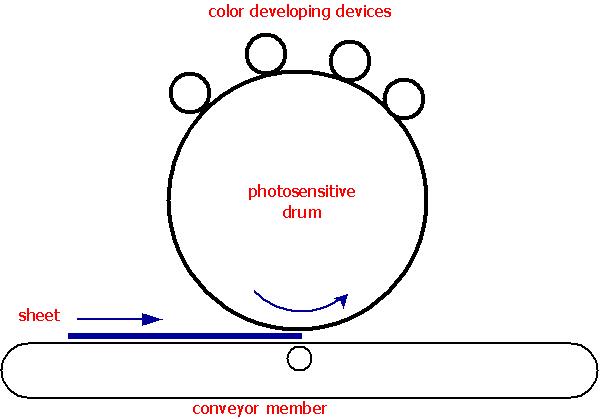
This place covers:
Transfer of toner image onto an intermediate transfer member after a single rotation of the photosensitive member. Example:
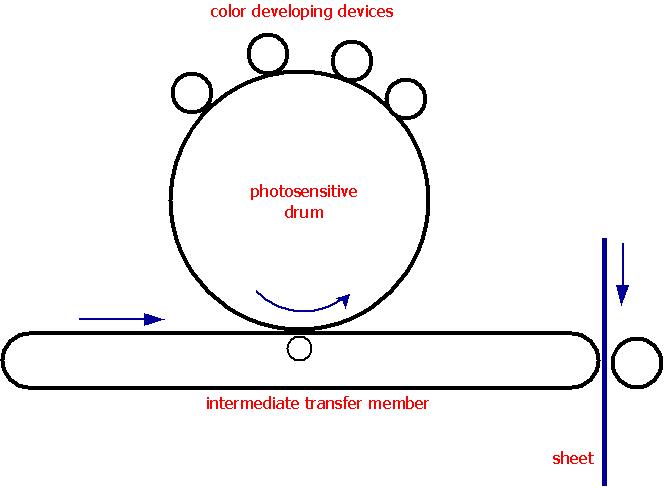
This place covers:
Plural rotations of the photosensitive member, e.g. when using a rotating set of developing units. Example:
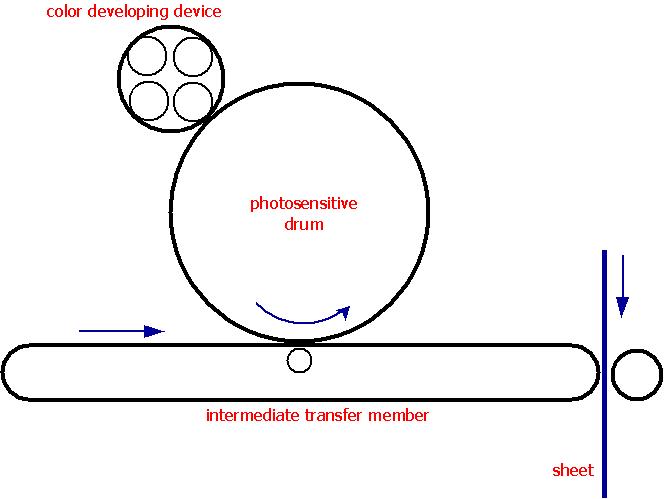
This place covers:
At least one photosensitive member with >= 2 developing units (takes precedence). Example:
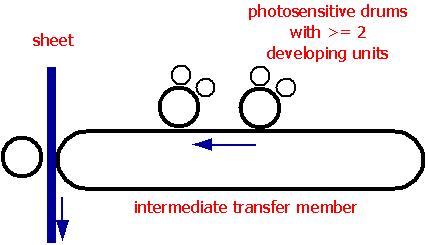
This place covers:
Primary transfer onto an intermediate transfer member. Example:
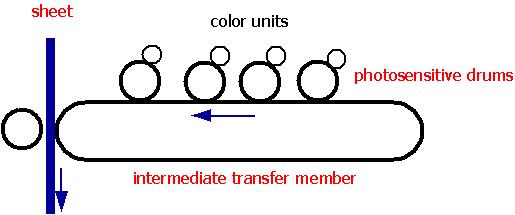
This place covers:
Primary transfer onto the recording sheet. Example:
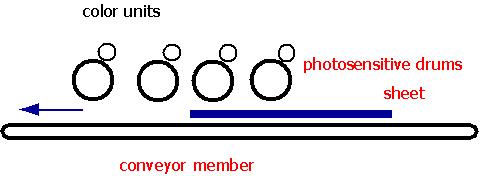
This place covers:
Charging means for charging the photosensitive recording member, e.g. roller, brush, corona.
Arrangements for cleaning and maintenance of charging apparatus and the control of charge.
Attention is drawn to the following places, which may be of interest for search:
Corona chargers |
This place covers:
Proximity charging means forming microgap like a charging roller held in small distance from surface to be charged e.g. by spacers, but not coronas.
This place covers:
Illuminating systems, light sources and optical elements provided for projecting or exposing the original image onto the photosensitive recording member in order to form the latent charge pattern by charging the recording surface at distinct portions.
The sensitizing light hereby is either reflected from the original image and directly projected onto the photosensitive surface or it is light e.g. originating from a laser which corresponds to the original image data as received from other sources like a scanner (digital copiers) or from computer modified/generated image data and is exposed onto the photosensitive surface.
Attention is drawn to the following places, which may be of interest for search:
LED heads | |
Optical scanning | |
Projection printing apparatus | |
Lamp housings for copying cameras, reflex exposure lighting | |
Laser printers | |
Scanning heads, means for illuminating the original | |
Composing, repositioning of picture signals |
This place covers:
Arrangements for exposing the image information provided otherwise than by directly projecting the original image onto the photosensitive recording material, i.e. digital copies.
Details of the projection optics relating to variable magnification: G03G 15/041 takes precedence.
Means for controlling illumination or exposure e.g. by optical elements, but directed to variable magnification: G03G 15/043 takes precedence.
This place covers:
Exposure from behind the photosensitive surface, e.g. exposure from inside a photosensitive drum.
This place covers:
Means for charging or discharging distinct portions of the charge pattern on the recording material, e.g. for contrast enhancement or discharging non-image areas.
Means for forming composite images, e.g. image editing: G03G 15/36 takes precedence.
Means for eliminating residual charges on the photoconductor: G03G 21/06 takes precedence.
This place covers:
Arrangements and means for developing the latent charge pattern recorded on a photosensitive surface using a solid powder developer (toner).
In patent documents, the following words/expressions are often used as synonyms:
- developer or toner for the developing agent. However sometimes "developer" is also used for the developing unit as whole.
In patent documents, the word/expression in the first column is often used instead of the word/expression in the second column, which is used in the classification scheme of this place:
"developing roller" | "donor member" |
This place covers:
Means for developing a latent image by cascading, old technique.
This place covers:
Means for developing a latent image in a powder cloud.
This place covers:
Development using a brush; however developing means using magnetic toner brushes are classified in G03G 15/09, G03G 15/095.
This place covers:
The most common development means is donor element, normally a roller or a belt.
All means in direct functional relation or contact to the donor element, e.g. a toner supply roller (= roller for applying the developing agent to the donor element), a doctor blade, distance holders, toner recovery and cleaning of the donor member and the structure of the donor member itself are classified here and in the respective subgroups of G03G 15/0806.
This place covers:
Means for developing a latent image through immersion, old technique.
This place covers:
Arrangements for supplying fresh developer, e.g. toner cartridges.
Means for conditioning developer in the developing unit and removing old developer therefrom.
Testing means for the developing agent.
Attention is drawn to the following places, which may be of interest for search:
In patent documents, the following words/expressions are often used as synonyms:
- "container" and "cartridge"
In patent documents, the word/expression in the first column is often used instead of the word/expression in the second column, which is used in the classification scheme of this place:
"toner" or "marking material" | "developer" |
This place covers:
Arrangements for purging used developer from the developing unit, i.e. removing used and deteriorated developer to the outside of the unit.
This place covers:
Arrangements for testing or measuring developer properties or quality, e.g. developer level, concentration, charge, size or flowability.
Monitoring means for toner consumption: G03G 15/556.
This place covers:
The developer storing means.
Arrangements for supplying new developer, e.g. a detachable developer cartridge.
Also stirrer, agitator provided in the cartridge.
Details of developer cartridges.
This place covers:
The interface between the developer cartridge and the developing unit.
Arrangements for metering and dispensing developer from a developer cartridge into the development unit, i.e. all the means provided at the interface between a (detachable) toner cartridge and the developing unit, e.g. conveyor screws, seals.
This place covers:
Managing developer material inside the developing unit.
Arrangements for conveying and conditioning developer inside the developing unit, e.g. agitating, removing impurities or humidity, e.g. augers, stirrer.
This place covers:
Arrangements for transferring
a toner pattern: G03G 15/16
a charge pattern: G03G 15/18
to a second base.
The "second base" is either an intermediate transfer member (transfer onto and from the intermediate transfer member e.g. in colour machines) or the final recording medium (transfer from the photosensitive member e.g. onto the recording sheet in a nip).
In patent documents the following expressions/words "intermediate transcription / transfer member", "second transcription / transfer member" and "middle - transcription / transfer member" are often used as synonyms for a toner image carrying member receiving a toner image from the electrographic recording member (= 1st transfer) and the transferring the image to the final recording material (2nd or final transfer).
In patent documents such expressions are often used instead of the wording "second base" or "intermediate support" which is used in the classification scheme of this group.
Driving mechanism e.g. gears, couplings, belt tensioning: G03G 15/1615 .
Details: e.g. chemical composition: G03G 15/1615.
The detection of a toner image or of a test patch on an intermediate transfer member e.g. for development and colour registration control is classified in G03G 15/5054 and G03G 15/0131.
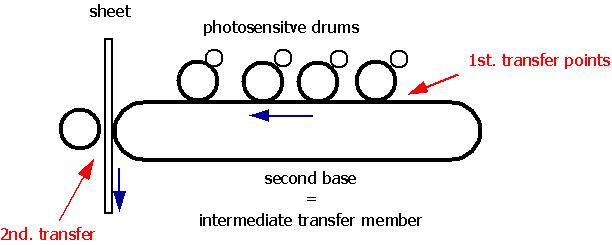
This place covers:
Transfer onto other materials than paper, e.g. OHP, but not to an intermediate transfer member.
Special recording materials and substrates: G03G 15/6591.
This place covers:
Transfer from the photosensitive member onto second base other than intermediate member and having no nip and using the force produced by an electrostatic transfer field formed between the second base and the electrographic recording member, e.g. through an air gap, corona. Example:
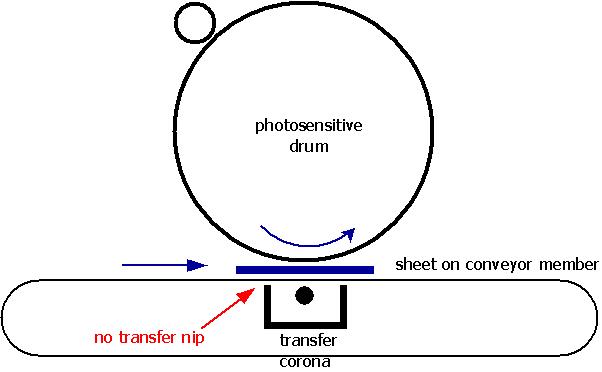
This place covers:
Transfer from the photosensitive member onto second base other than intermediate member in a nip by introducing the second base in the nip formed by the recording member and at least one transfer member of e.g. transfer roller or transfer conveying belt, e.g. in combination with bias or heat. Example:
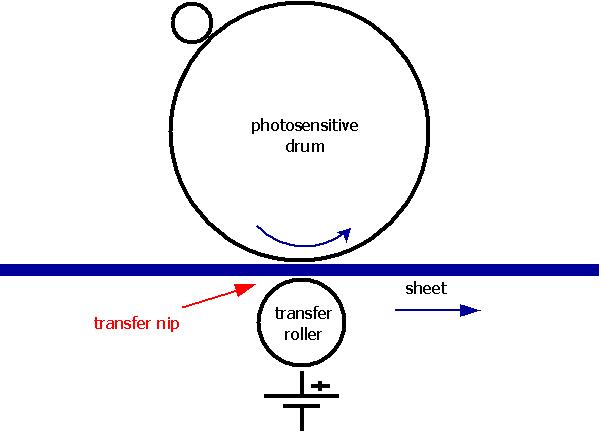
This place covers:
Devices and processes for fixing a toner image on a recording medium.
Fixing by heat is mostly combined with pressure in the nip between a contact heating element and an opposing pressure element.
Attention is drawn to the following places, which may be of interest for search:
Classification guidance
- Fixing by heat is classified in G03G 15/2003
- Fixing by pressure only is classified in G03G 15/2092
- Fixing by using a solvent is classified in G03G 15/2096
- Fixing by using light, e.g. UV is classified in G03G 15/2098
In patent documents, the following words/expressions are often used as synonyms:
- "eddy current heating", "induction/ electromagnetic / magnetic heating" and "magnetic flux heating"
This place covers:
Arrangements and processes which involve the combination of more than one step of charging and imagewise exposing, developing a latent charge pattern and transferring and fixing of the developed toner image.
In patent documents, the following abbreviations are often used:
DEP | direct electric printing |
This place covers:
Means directed to the general control of the image forming apparatus, e.g. regulating different parts of the machine, multimode copiers, microprocessor control (sequencing control: G03G 21/14).
Processes and methods directed to control the apparatus.
Attention is drawn to the following places, which may be of interest for search:
Administration of office machines |
This place covers:
Illustrative example of subject matter classified in this group.
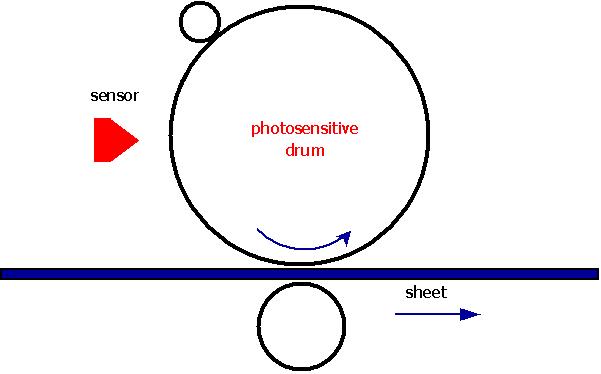
This place covers:
Illustrative example of subject matter classified in this group.
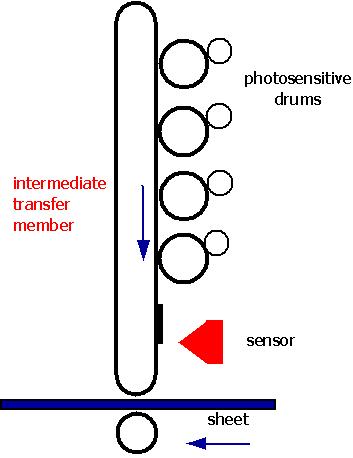
This place covers:
Illustrative example of subject matter classified in this group.
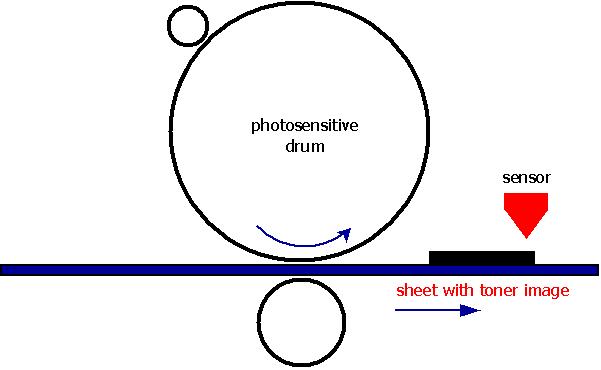
This place covers:
Means and apparatus for handling the final recording material inside the apparatus and in post-processing devices.
Attention is drawn to the following places, which may be of interest for search:
Conveying or guiding webs | |
Handling of sheets and webs in printing apparatus inkjet printers | |
General handling of sheets and webs | |
Removing sheets from printing cylinders | |
Sheet binding in general | |
Sheet folding in general |
This place covers:
Electrographic processes using deformation of thermoplastic layers.
Attention is drawn to the following places, which may be of interest for search:
Layers for surface-deformation imaging | |
Shaping of plastic objects with thermoplastic memory effect | |
Digital stores using thermoplastic elements | |
Television signal recording using deformable thermoplastic recording medium |
This place covers:
Electrographic apparatus and processes using an electric conductivity pattern; radiation field photography, e.g. Kirlian photography, colour-discharge photography (G03G 17/005); electrolytic development (G03G 17/02); photoelectrophoresis (G03G 17/04); using migration imaging (G03G 17/10).
This place covers:
Processes for producing patterns which are not produced by charge pattern, which is done by chargeless electrophotography, the process to produce an optical image involves electrolytic development.
This place covers:
processes for producing patterns which are not produced by charge pattern , the process involves photoelectrophoresis using a photoconductive element; an colloidal liquid is applied to one surface of a photoconductor while the optical image is focused on the opposite side.
This place covers:
Devices that are suitable for providing processes for producing patterns which are not produced by charge pattern.
This place covers:
Processes for producing patterns which are not produced by charge pattern using an electrophoto-adhesive process such as manifold imaging, which means a selective removal of the photoconductive material of the fracturable photoconductive layer by adhesion.
This place covers:
Processes for producing patterns which are not produced by charge pattern using migration imaging such as photoelectrosolography.
This place does not cover:
Using photoelectrophoresis |
This place covers:
Electrographic apparatus and processes using magnetic patterns, magnetography; selective demagnetizing (G03G 19/005).
This place covers:
All arrangements which basically relate to features of the
- cleaning of the photosensitive member.
- conditioning of the photosensitive member e.g. lubrication.
- collection and storage of waste toner.
- counting and billing of copies.
- security copying, e.g. watermarking.
- control of the inner apparatus environment.
Mechanical means for facilitating the maintenance of the apparatus, e.g. modular arrangements (G03G 21/16) or modular arrangements using process cartridges (G03G 21/18).
Examples of places in relation to which this place is residual:
Electrographic processes using a charge pattern | |
Apparatus for electrographic processes using a charge pattern | |
Electrographic processes using deformation of thermoplastic layers; Apparatus therefor | |
Processes using magnetic patterns; Apparatus therefor; Photoelectrosolography; Processes involving a selective transfer, e.g. electrophoto-adhesive processes; Apparatus essentially involving a single such process | |
Processes using magnetic patterns; Apparatus therefor |
Attention is drawn to the following places, which may be of interest for search:
Security printing | |
Preventing of unauthorised reproduction |
This place covers:
All arrangements with respect to the outer and inner structure of an electrophotographic apparatus, like modular arrangements, cartridges, frame and door structures.
This place covers:
Means for handling the different functional units of the apparatus in the apparatus;
This place does not cover:
Arrangement or disposition of the entire apparatus | |
For connecting the different parts of the apparatus |
This place covers:
Process cartridges for electrophotographic image forming apparatus.
A process cartridge comprises at least two image processing means provided in a single mostly detachable unit or frame.
Most of the process cartridges comprise the photosensitive member and at least one image processing means selected from charging means, developing means, transfer means or cleaning means.
However there a process cartridges, which do not comprise a photosensitive member but more than one image processing means. These units are classified in group G03G 21/1835 (precedence).
Attention is drawn to the following places, which may be of interest for search:
A cartridge for a single image forming process means e.g. a developing cartridge alone |
A developing cartridge, when it's adapted to be fit into a separate photo drum cartridge, is seen as a sub module of a process cartridge that does comprise at least two image processing means, and therefore it can be classified in this group.
This place covers:
Means for handling the process cartridge in the apparatus body; details about interactions between the cartridge and the main machine, except for those that go under G03G 21/1875; mostly, it's about guiding the cartridge in and out of position and providing drive and electrical power to it.